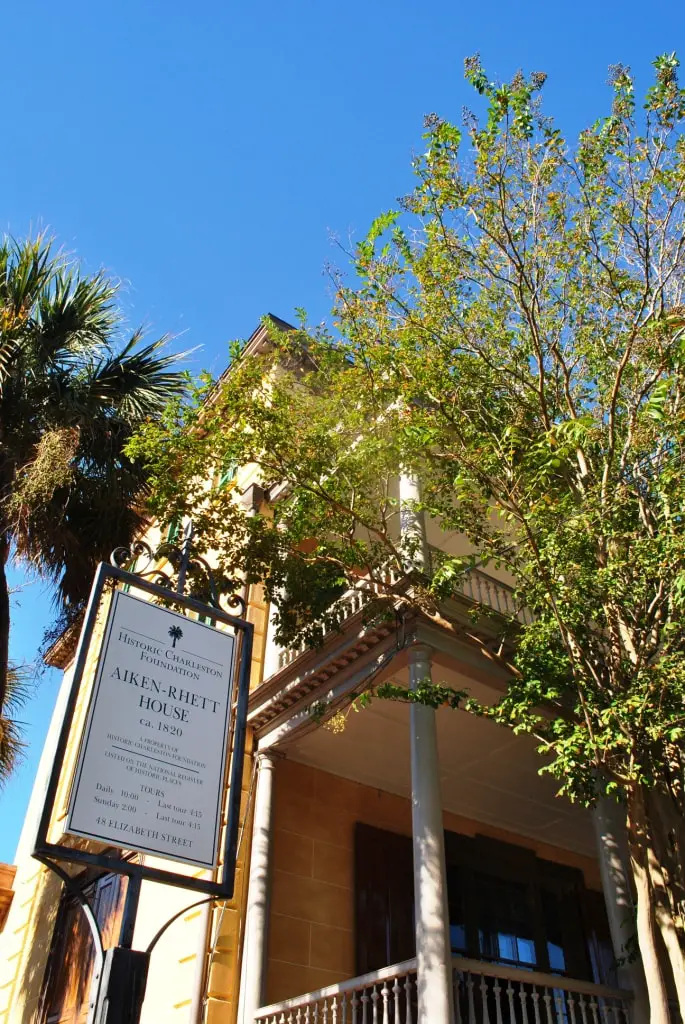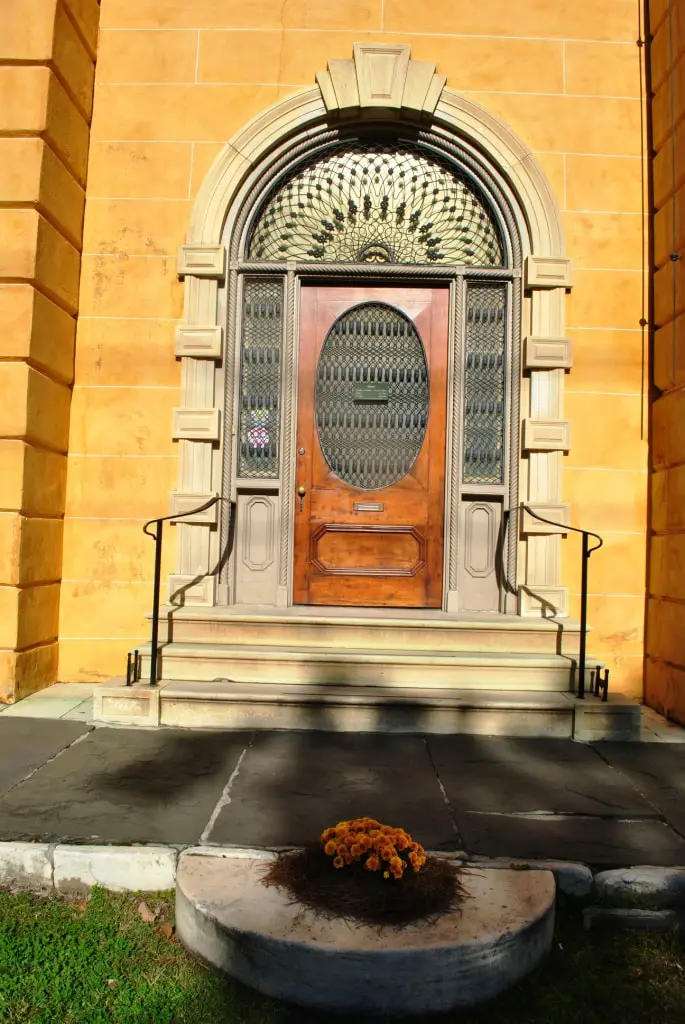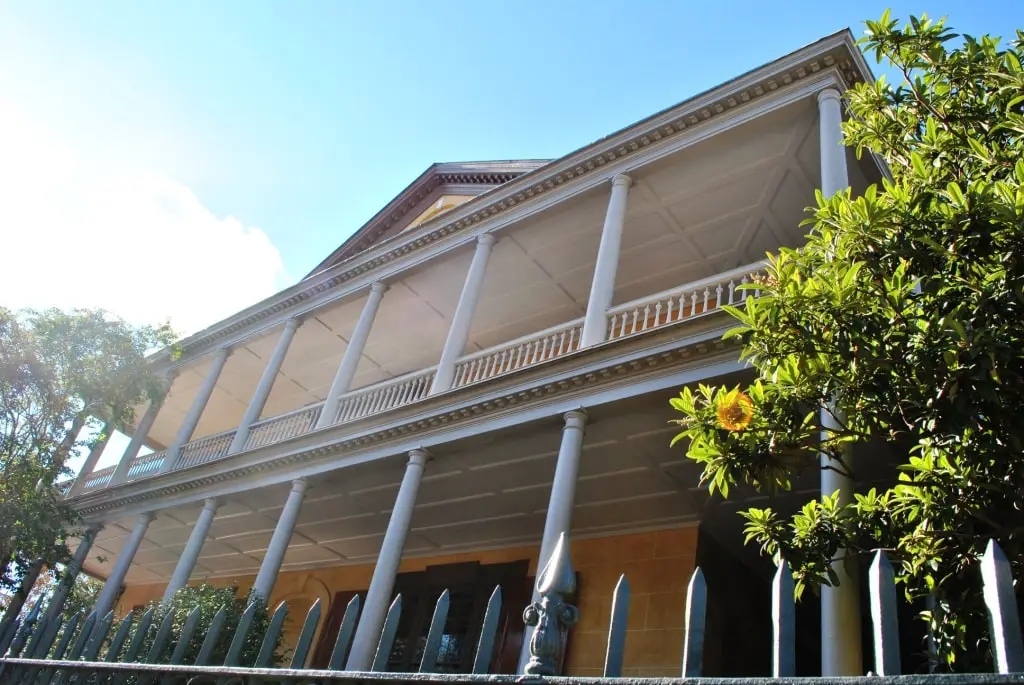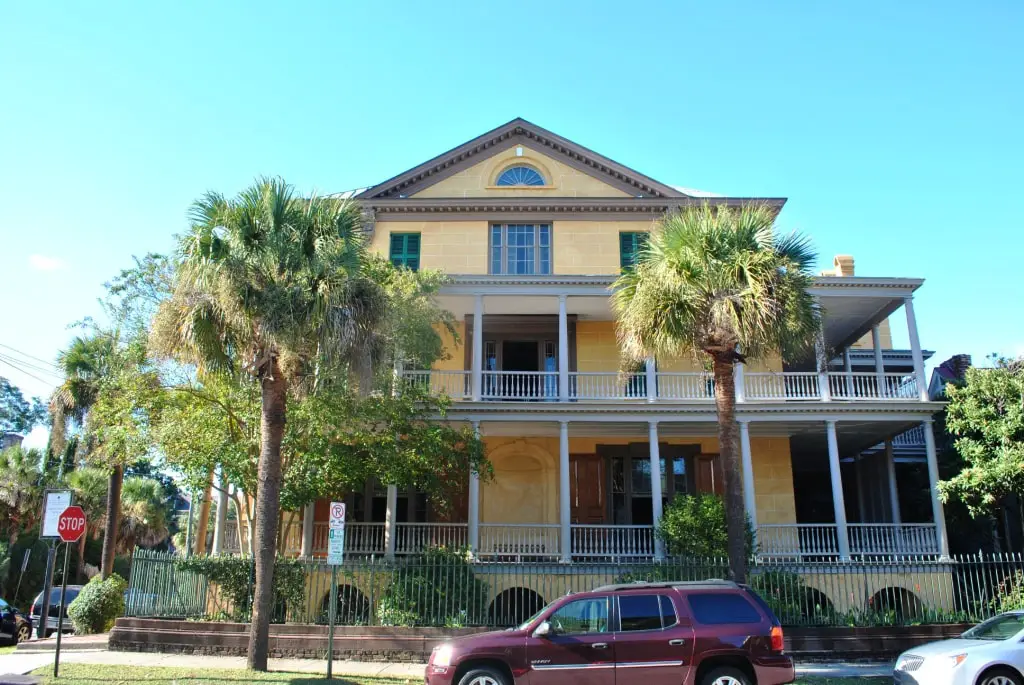William Aiken House: A Charleston Landmark
Nestled in the heart of Charleston, South Carolina, the William Aiken House is a testament to the city’s rich history and architectural heritage.
Constructed in 1820 by John Robinson, this historic residence at 48 Elizabeth Street has witnessed nearly two centuries of Charleston’s evolution.
In 1827, William Aiken Sr., a prominent figure in South Carolina’s political and commercial spheres, acquired the property.
His son, William Aiken Jr., furthered the family’s legacy, serving as South Carolina’s governor from 1844 to 1846 and later in the U.S. House of Representatives.
The house, a blend of Federal, Greek Revival, and Victorian architectural styles, has undergone significant modifications, including a notable expansion in 1857-58.
Today, the William Aiken House is a key historical site and a focal point for things to do in Charleston, South Carolina.
Since 1995, the Historic Charleston Foundation has been overseeing the William Aiken House, providing visitors with an insight into the luxury lifestyle of the 19th-century upper class and the intricate history of the pre-Civil War South.
The Historical Genesis of the William Aiken House
The Early Beginnings and Architectural Evolution
The William Aiken House, a landmark in Charleston’s Wraggborough neighborhood, was originally built in 1820.
Its creator, John Robinson, envisioned a Charleston double house, a style reflective of the city’s architectural trends.
The property, situated on lots acquired in 1817, initially symbolized Robinson’s prosperity.
However, its historical significance was magnified in 1827 when William Aiken Sr., a leader in South Carolina’s burgeoning railroad industry as the president of the South Carolina Canal and Railroad Company, purchased the house.
This acquisition began the house’s association with one of South Carolina’s most influential families.
The Aiken Era: A Legacy of Influence and Transformation
Under the Aikens, the house transformed both in structure and stature.
William Aiken Sr., besides his commercial exploits, was a member of the state House of Representatives from 1824 until his untimely death in 1831.
His son, William Aiken Jr., inherited the property and further elevated the family’s status.
Aiken Jr.’s tenure as a rice planter and politician, including his service as South Carolina’s governor (1844-1846) and later as a U.S. Congressman (1851-1857), turned the house into a political and social activity hub in Charleston.

Architectural Splendor and Modifications
The Blend of Architectural Styles
The William Aiken House is a remarkable example of architectural transition.
Its original Federal style, characterized by symmetry and simplicity, was later complemented by Greek Revival features, notably in its grand columns and pediments.
The Victorian influence, visible in the later additions to the house, added a layer of ornate detailing and complexity.
This blend of styles makes the home a unique specimen in Charleston’s architectural history, showcasing the city’s transition through different aesthetic periods.
Significant Alterations and Additions
Throughout its history, the house underwent significant alterations, most notably around 1833, when major structural modifications were made. 1857-58, a one-story wing was added, designed specifically as an art gallery.
This addition not only expanded the physical footprint of the house but also enriched its cultural significance, reflecting the Aiken family’s status and patronage of the arts.
A Testament to Architectural Preservation
Today, the William Aiken House is a well-preserved example of 19th-century architecture.
Its stucco-over-brick construction, Doric double piazza, and tin roof are characteristic of the period’s building techniques.
The preservation of the house, overseen by the Historic Charleston Foundation, ensures that these architectural elements remain intact, offering contemporary visitors a window into the past.
The house, now a historic museum, continues to draw attention not only for its architectural beauty but also for its historical significance in the tapestry of Charleston’s history.

The Aiken Family and Their Era
Life in the Mid-19th Century Charleston
The Aiken family’s tenure at the house coincided with significant social and economic change in Charleston.
During the mid-19th century, Charleston was a bustling hub of commerce and culture. The Aiken family, particularly under William Aiken Jr.’s stewardship, was at the forefront of this transformation.
In its grandeur, the house mirrored the opulent lifestyle of Charleston’s elite. Lavish parties, elaborate dinners, and a rich social calendar were typical of the era, and the Aiken House hosted many such events.
William Aiken Jr.: A Man of Many Facets
William Aiken Jr.’s influence extended beyond his home. As a prominent rice planter, he was deeply involved in the region’s agricultural development.
His political career, marked by his tenure as governor and later as a congressman, saw him engage in pivotal discussions shaping South Carolina’s and the nation’s future.
His contributions to the South Carolina Canal and Railroad Company were also significant, reflecting the era’s industrial progress.
The Contrast of an Era
The grand lifestyle of the Aiken family, characterized by European travels, fine clothing, and an art collection, stood in stark contrast to the harsh realities of the time, particularly the institution of slavery.
The Aiken House, in its splendor, was a microcosm of this dichotomy, juxtaposing the luxury of the elite with the struggles of the enslaved people who maintained it.
Preservation and the Historic Charleston Foundation
The Transition to Preservation
In 1975, the Aiken House embarked on a new chapter when it was donated to the Charleston Museum by Mrs. Frances Dill Rhett, a direct descendant of Governor William Rhett. This marked the beginning of the house’s journey towards preservation.
In 1995, the Historic Charleston Foundation, an organization dedicated to preserving Charleston’s architectural, historical, and cultural integrity, acquired the house.
Their stewardship has been instrumental in maintaining the house’s historical authenticity.

Challenges and Strategies in Preservation
Preserving the William Aiken House has been a formidable task, particularly given Charleston’s humid and hurricane-prone climate.
The foundation has employed various strategies to protect the house’s structural integrity and original furnishings, artwork, and décor.
This approach has ensured that the house remains a true representation of its time, offering visitors an authentic glimpse into Charleston’s past.
The House as a Cultural and Educational Hub
Under the Historic Charleston Foundation’s management, the William Aiken House has become more than a preserved historical site.
It has become a cultural and educational hub, hosting various events and programs that educate the public about Charleston’s history.
The foundation’s efforts have ensured that the house remains a vital part of Charleston’s living history, connecting the past with the present.
Slavery and the Aiken-Rhett Legacy
The Role of Slavery in the Aiken Household
The history of the William Aiken House is deeply intertwined with the history of slavery in the American South.
In the 1850 census, it was recorded that William Aiken Jr. enslaved seven individuals within the urban residence, a number that increased to 19 by 1860.
These enslaved individuals were integral to the house’s functioning and maintenance, reflecting the era’s grim reality.
The Aiken family, like many others in Charleston and the broader Southern United States, relied on the labor of enslaved people, not only in their urban residences but also across their extensive agricultural holdings.
The Aiken-Rhett Property: A Microcosm of Antebellum Charleston
The Aiken-Rhett House serves as a poignant reminder of the stark contrasts in living conditions during the antebellum period.
The luxurious lifestyle of the Aiken family was made possible by the backbreaking labor of enslaved individuals.
The property, with its elegant main house and the more austere slave quarters, encapsulates the economic and social disparities of the time.
This aspect of the house’s history is crucial in understanding the complex narrative of Charleston’s past.
Uncovering the Past: Archaeological Insights
Recent archaeological efforts have shed more light on the lives of the enslaved people at the Aiken-Rhett House.
Excavations have unearthed artifacts that offer a glimpse into their daily lives, further enriching the historical narrative of the property.
These findings contribute significantly to the understanding of slavery in urban settings, contrasting with the more commonly studied plantation slavery.

The William Aiken House Today: Exhibits and Interpretation
Showcasing History Through Exhibits
Today, the William Aiken House functions as a museum, showcasing various exhibits that narrate its rich history.
These exhibits include original furnishings, artwork, and artifacts discovered on the property. The art gallery, added in 1857-58, remains a highlight, featuring collections that reflect the artistic tastes of the era.
The house’s preservation allows visitors to step back in time and experience the grandeur of 19th-century Charleston.
Enhancing Visitor Experience with Technology
To make the history of the Aiken-Rhett House more accessible, the Historic Charleston Foundation has developed a mobile app.
This app offers self-guided audio tours, providing in-depth information about the house and its inhabitants.
Launched in 2018, the app includes descriptions and photographs of various exhibits, enriching the visitor experience.
This technological integration represents a modern approach to historical education, making the house’s complex history more understandable and engaging for a contemporary audience.
A Living Monument to Charleston’s History
Today, William Aiken House is a preserved historical site and a living monument to Charleston’s history.
It serves as an educational resource, offering insights into the city’s architectural evolution, social history, and the legacy of slavery.
Through its exhibits and educational programs, the house continues to play a vital role in preserving and interpreting the history of Charleston for future generations.

Reflecting on the William Aiken House Legacy
A Symbol of Charleston’s Historical Tapestry
With its rich history and architectural beauty, the William Aiken House is a significant symbol of Charleston’s past.
It encapsulates the city’s journey through the antebellum era, the complexities of the Civil War period, and into the modern day.
This house is not just a static monument but a dynamic testament to the many layers of history that have shaped Charleston.
It serves as a reminder of both the grandeur of the city’s elite and the painful realities of those who lived under the shadow of slavery.
The Importance of Preservation
Preserving the William Aiken House underscores the importance of safeguarding historical landmarks.
Through the efforts of the Historic Charleston Foundation and other preservationists, the house remains a vital link to the past.
Its continued maintenance and the educational programs it supports are crucial in keeping the history of Charleston alive.
These efforts ensure that future generations can learn from and appreciate the complex narrative of this historic city.
A Living Educational Resource
The William Aiken House remains a valuable educational resource as we move forward. It offers a tangible connection to the past, providing insights into Charleston’s architectural, social, and cultural history.
The house’s role in educating the public about the multifaceted history of the South, particularly regarding slavery and the lives of the enslaved, is invaluable.
It stands as a beacon of learning, inviting visitors to delve into the depths of Charleston’s rich historical heritage.
